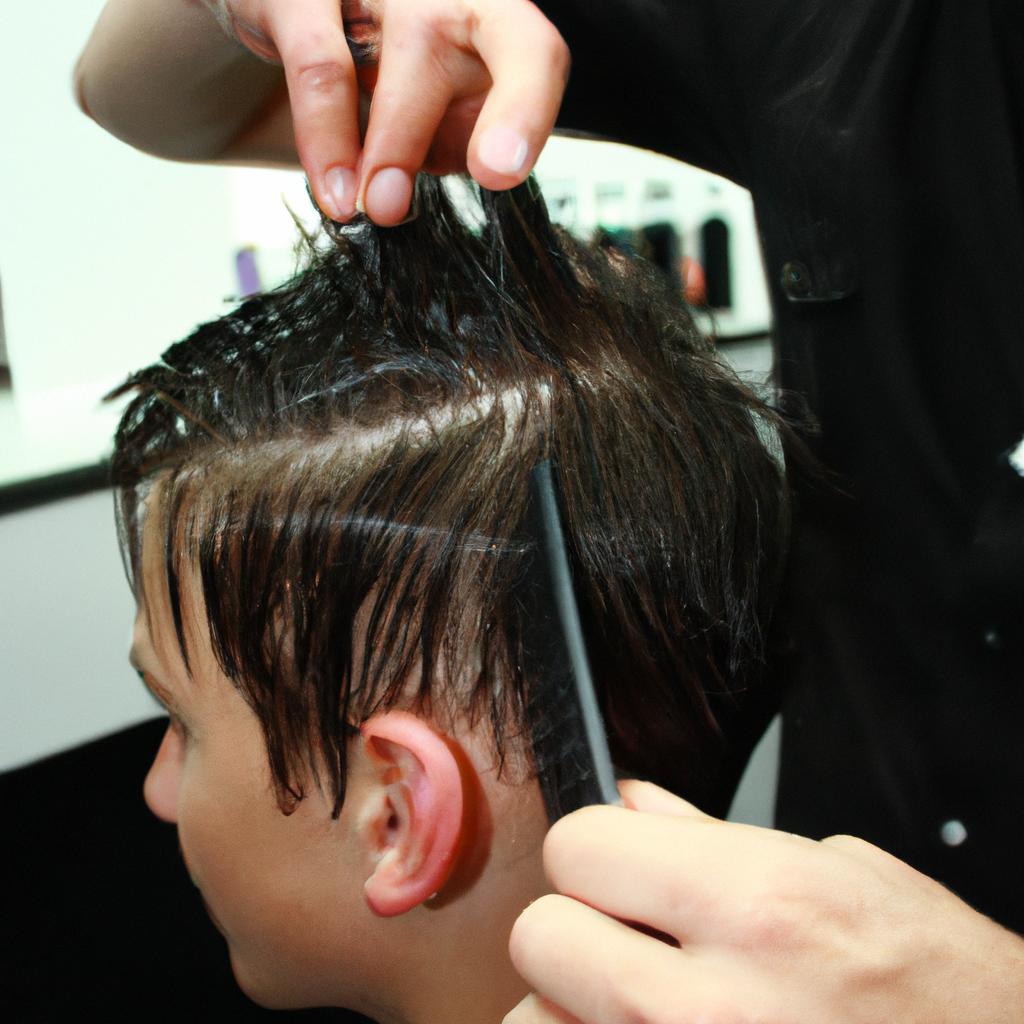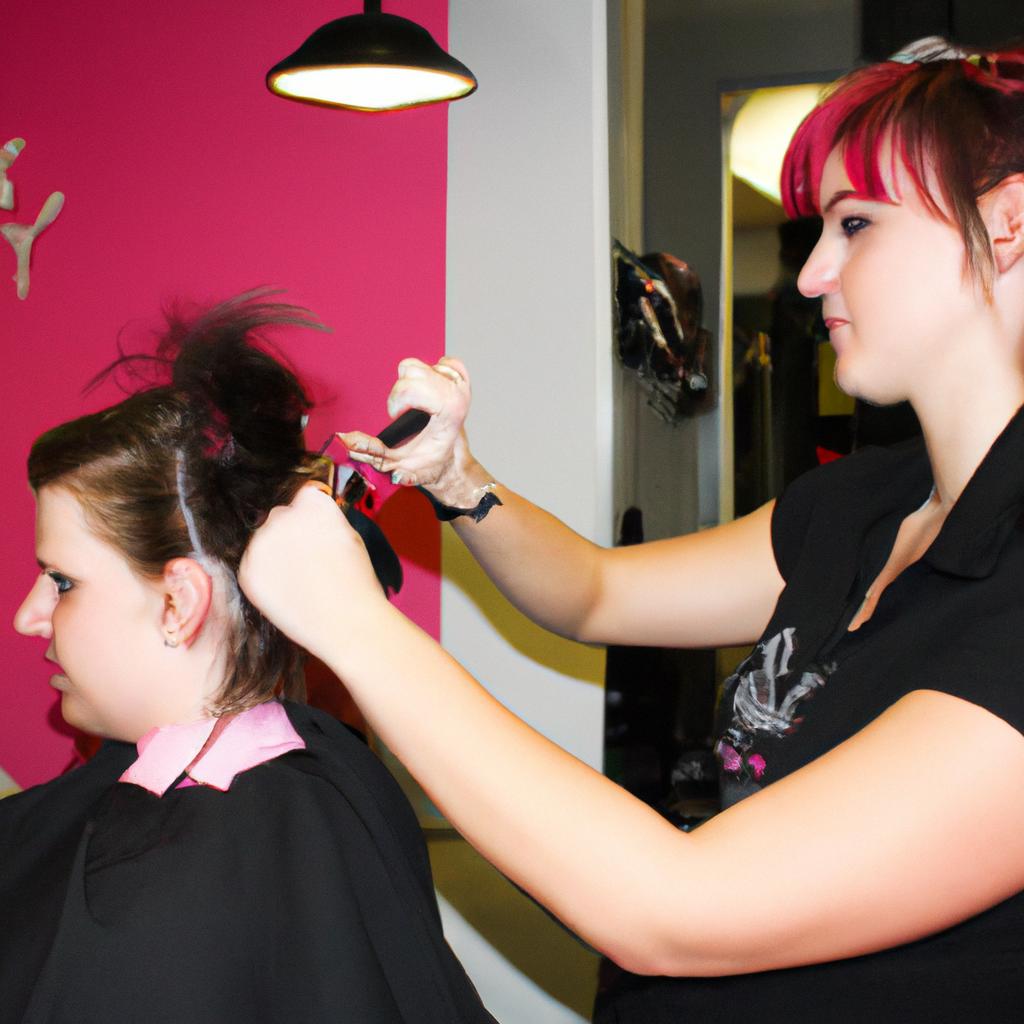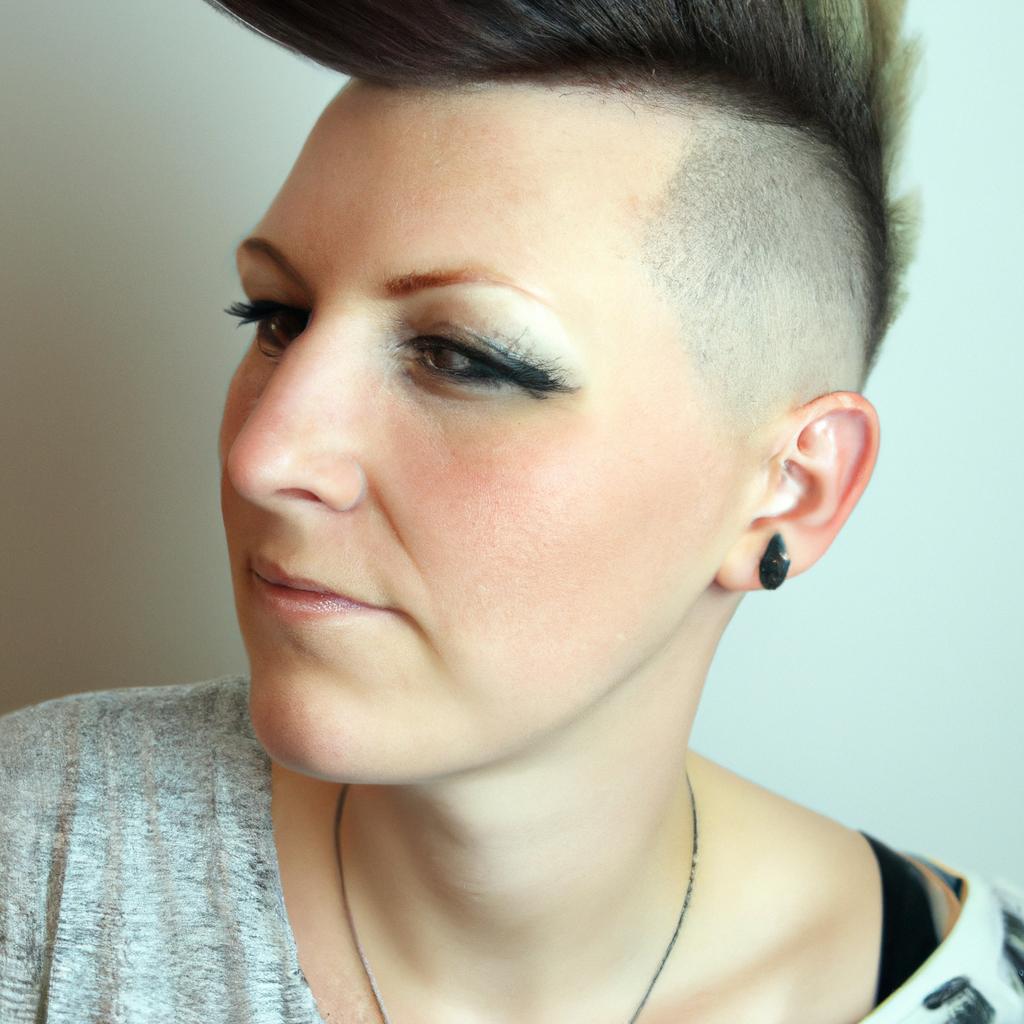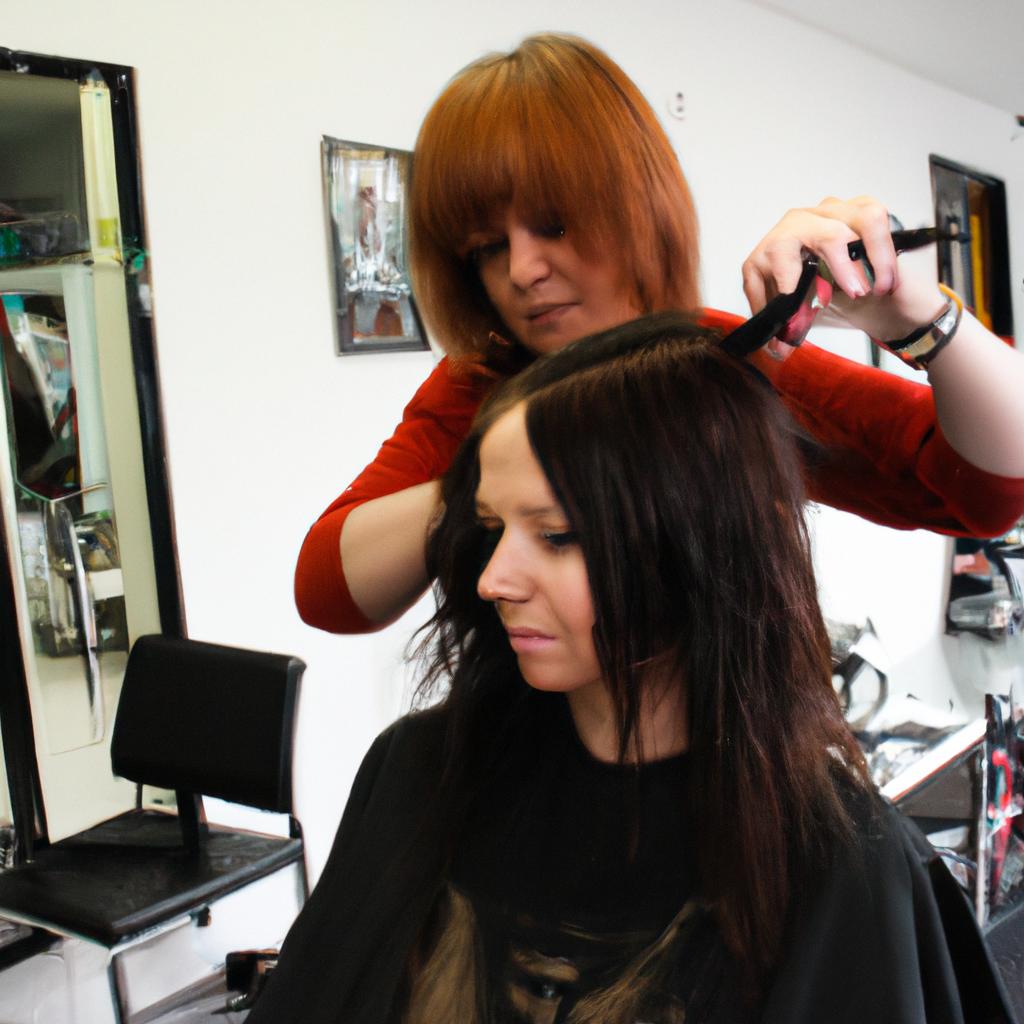Undercut haircuts have gained significant popularity in recent years, becoming a staple among fashion-forward individuals seeking a bold and edgy look. This hairstyle involves shaving or cutting the hair short on the sides and back while leaving longer strands on top, creating a striking contrast between lengths. For salon hairdressers, mastering the art of undercut haircuts is essential to meet the demands of clients who desire this trendy style.
To illustrate the impact of an exceptional undercut haircut, let us consider the hypothetical case of Emma, a young professional looking to revamp her appearance. Emma approached her trusted salon with a vision of sporting an undercut haircut that would exude confidence and sophistication. By skillfully executing precise techniques and carefully considering Emma’s facial features and personal preferences, the hairstylist transformed her dull locks into a stylish masterpiece. The result? A stunning transformation that not only left Emma feeling empowered but also garnered compliments from friends and colleagues alike.
In this comprehensive guide for salon hairdressing professionals, we will delve into various aspects related to undercut haircuts. From understanding different variations of undercuts to learning proper techniques for achieving seamless transitions between lengths, this article aims to equip hairstylists with the knowledge and skills necessary to excel in offering impeccable services to their clientele.
Understanding Undercut Haircuts
Imagine a scenario where Sarah, a 25-year-old professional, walks into a salon in search of a trendy and edgy hairstyle. Her hair is long and she wants to transform her look by opting for an undercut haircut. This style involves shaving or trimming the hair on the sides and back while leaving the top section longer. Understanding the intricacies of undercut haircuts is crucial for hairstylists to meet their clients’ expectations and provide them with a personalized experience.
To fully comprehend undercut haircuts, it is essential to explore their history and evolution. Originally popularized in the punk rock subculture of the 1970s, these hairstyles have since become mainstream fashion statements across various genders and age groups. Today, they offer versatility in terms of length, texture, and styling options. By understanding how this style has evolved over time, hairstylists can better navigate its nuances and create unique looks that cater to their clients’ preferences.
When discussing undercut haircuts, it’s important to address both aesthetic appeal and practical considerations. The dramatic contrast between the shaved sections and the longer top allows individuals to express their personality through bold choices while maintaining professionalism when needed. Furthermore, this style offers low maintenance as compared to other intricate hairstyles – a factor that appeals to busy professionals like Sarah who seek effortless yet stylish alternatives.
- Emphasizes individuality
- Enhances facial features
- Provides versatile styling options
- Allows for easy adaptation from casual to formal occasions
Markdown Table:
| Advantages | Disadvantages | Considerations |
|---|---|---|
| Easy maintenance | Requires regular touch-ups | Suitable face shape |
| Versatile styling options | May not be suitable for all hair types | Confidence level |
| Can enhance natural facial features | Longer grow-out period may require patience | Professional environment suitability |
| Allows for personal expression | May not suit everyone’s style preferences | Hair texture compatibility |
In conclusion, understanding the history, practicality, and aesthetic appeal of undercut haircuts is essential in providing a tailored experience to clients like Sarah. By recognizing how this style has evolved over time and incorporating versatile options, hairstylists can help individuals express their personality while considering factors such as face shape, hair type, and lifestyle choices. Now that we have explored the foundations of undercut haircuts, let us delve into the next step: choosing the right undercut style based on individual preferences and characteristics.
Choosing the Right Undercut Style
Section H2: Understanding Undercut Haircuts Continued
Case Study: Imagine a client named Sarah who walks into your salon seeking an undercut haircut. She has long, thick hair and wants to experiment with a bold and edgy look. As a hairstylist, it is crucial to understand the various aspects of undercut haircuts in order to provide her with the best advice and service possible.
To ensure that you can meet Sarah’s expectations and create a stylish undercut, here are some key considerations:
-
Hair Texture: The texture of the client’s hair plays a vital role in determining the suitability of an undercut style. Coarse or curly hair may require additional techniques such as texturizing or thinning to achieve the desired look.
-
Face Shape: Different face shapes complement different undercut styles. For example, individuals with round faces may benefit from side undercuts that add definition, while those with angular faces can pull off full undercuts more effortlessly.
-
Maintenance Level: It is essential to discuss maintenance requirements with the client beforehand. Some undercuts demand regular touch-ups due to fast hair growth patterns, making them higher maintenance than others.
-
Personal Style: Consideration for personal style preferences ensures that clients feel confident and comfortable sporting their new haircut daily. Collaborating on design elements like shaved patterns or asymmetrical lines allows for personalized expressions within this versatile hairstyle.
Table – Pros and Cons of Undercut Hairstyles:
| Pros | Cons |
|---|---|
| Offers versatility | Requires frequent upkeep |
| Adds edge to any look | Limits hairstyle options |
| Can be customized | May not suit all face shapes |
| Allows for creative designs | Requires professional expertise |
By understanding these key factors and considering each client individually, you can guide them towards selecting an appropriate undercut style that suits their unique features and lifestyle choices.
Transitioning seamlessly into our next section, “Preparing for an Undercut,” let’s delve into the necessary steps to ensure a successful and satisfying undercut experience.
Preparing for an Undercut
Transitioning smoothly from the previous section on choosing the right undercut style, we now delve into preparing for an undercut haircut. To illustrate this process, let’s consider a hypothetical scenario where a client named Sarah has decided to get an edgy undercut hairstyle and approaches her trusted hairstylist for guidance.
Firstly, it is important for both the stylist and the client to have a thorough understanding of what an undercut entails. An undercut involves shaving or trimming the hair at the sides or back of the head shorter than the hair on top. This creates a striking contrast between two different lengths and can be customized in various ways depending on personal preference.
To prepare for an undercut haircut, there are several key considerations that should be taken into account:
-
Hair Length: The length of the hair plays a crucial role in determining how drastic the undercut will appear. Generally, longer hair allows for more versatility in styling options, whereas shorter hair may limit the overall look.
-
Face Shape Analysis: Different face shapes complement different styles of undercuts. It is essential to analyze Sarah’s face shape to determine which type of undercut would best suit her features. For example:
- A round face could benefit from an asymmetrical undercut with added volume.
- A square-shaped face might find balance with a disconnected or textured undercut.
-
Maintenance Commitment: Undercut hairstyles often require regular maintenance due to their distinctive nature. Discussing this aspect with Sarah ensures she understands the commitment involved in maintaining her desired look.
-
Styling Products and Techniques: Introducing clients like Sarah to suitable styling products and techniques helps them maintain their new hairstyle effortlessly while achieving their desired aesthetics effectively.
To summarize, proper preparation is vital before embarking on an undercut haircut journey. Understanding factors such as hair length, face shape analysis, maintenance commitment, and appropriate styling products empowers both stylist and client alike to make informed decisions regarding this bold choice.
In our next section, we will delve into the step-by-step process of executing an undercut haircut. By following these guidelines, stylists can achieve impressive results that leave clients like Sarah feeling confident and satisfied with their new look.
Styling and Maintaining Your Undercut
Transitioning smoothly from the previous section, where we explored the process of getting an undercut haircut, let us now delve into the key aspects of styling and maintaining this trendy hairstyle. To better illustrate these points, consider the following hypothetical scenario:
Imagine you walk out of the salon after getting a fresh undercut. Your hair looks stylish and edgy, but what’s next? How do you style your new haircut to match different occasions and maintain its appeal over time? Here are some valuable tips:
-
Experiment with Different Products: Finding the right styling product is crucial for achieving various looks with your undercut. Whether it’s pomade, wax, or gel, experimenting with different products can help you achieve desired textures such as sleek and polished or messy and tousled.
-
Master Styling Techniques: Understanding how to use styling tools like combs, brushes, or even your fingers will enhance your ability to create diverse hairstyles with an undercut. Learning techniques such as slicking back for a formal look or adding volume for a casual appearance allows you to tailor your haircut according to specific occasions.
-
Prioritize Regular Trims: Maintaining the shape and sharpness of an undercut requires regular trims every few weeks. Scheduling appointments ensures that your stylist can tidy up any growing-out sections and keep your overall look clean and well-maintained.
- Confidence boost: The boldness associated with an undercut often leads people to feel more confident in their personal style.
- Expression of individuality: Undercuts provide individuals with a unique way to express themselves creatively.
- Sense of rebellion: This daring hairstyle can evoke feelings of rebelliousness against conventional norms.
- Instant attention-grabber: The unconventional nature of undercuts tends to capture immediate attention wherever one goes.
| Undercut Variation | Description | Best Suited For |
|---|---|---|
| Disconnected | Sharp contrast between long and short sections | Those seeking a dramatic look |
| Faded | Gradual fade from longer hair on top to shorter sides | People desiring a subtle undercut |
| Textured | Incorporates various lengths and textures for added depth | Individuals wanting versatility in styling |
| Buzzed | Extremely short length all around for a low-maintenance option | Those with an active lifestyle |
With these valuable tips and insights into emotional responses associated with undercuts, we can now proceed to explore popular variations of this hairstyle. So let’s dive into how you can further customize your new haircut to truly make it your own!
Popular Variations of Undercut Hairstyles
Having discussed how to style and maintain your undercut, let us now explore some popular variations of this trendy hairstyle.
To better understand the versatility of undercut hairstyles, let’s consider a hypothetical case study. Imagine Sarah, a young professional seeking a bold yet sophisticated look. She visits her trusted hairstylist, who suggests different variations of undercuts based on Sarah’s preferences and facial features. This example illustrates how customized undercut styles can enhance one’s appearance while reflecting their individuality.
Below is a bullet point list presenting four popular variations of undercut hairstyles:
- Faded Undercut: This variation incorporates gradually fading hair length towards the nape of the neck or sides, creating a subtle transition between longer hair at the top and shorter hair underneath.
- Disconnected Undercut: With this style, there is a clear distinction between the long hair on top and shaved sides. The contrast creates an edgy aesthetic that is both fashionable and eye-catching.
- Textured Undercut: Adding texture through layers or texturizing techniques enhances volume and movement in the hair, giving it a more dynamic look.
- Pompadour Undercut: Combining classic elements with modern trends, this variation pairs an elevated pompadour at the front with shaved or closely cropped sides.
| Variation | Description | Best Suited For |
|---|---|---|
| Faded Undercut | Gradually fades hair length | Those seeking subtler changes |
| Disconnected Undercut | Clear distinction between long hair and shaved sides | Individuals with an edgy style |
| Textured Undercut | Enhances volume and movement in the hair | Those wanting a dynamic look |
| Pompadour Undercut | Elevated pompadour paired with shaved or closely cropped sides | Classic-meets-modern style enthusiasts |
By exploring these popular variations, individuals can find inspiration for their own undercut hairstyles. Remember to consult with your hairstylist who will consider various factors such as face shape, hair texture, and personal preferences when customizing the perfect undercut for you.
Incorporating different elements into your haircut not only reflects trends but also allows you to express creativity while maintaining a stylish appearance. Experimenting with these variations is an excellent way to embrace change and make a bold fashion statement.
Please let me know if there’s anything else I can assist you with!




